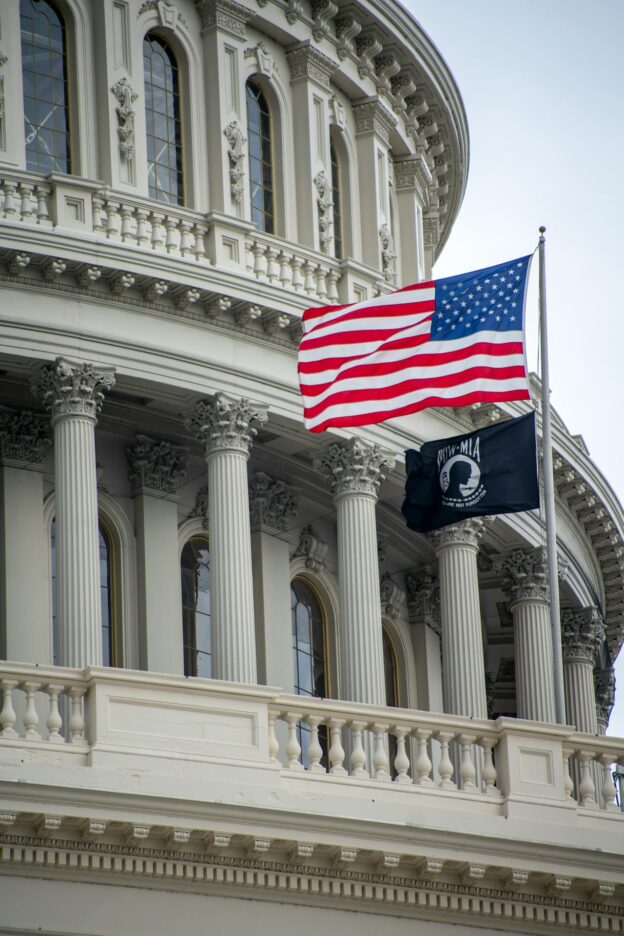For analysis on the government’s 10-Year Health Plan from GK’s Strategic Advisers Steve Brine and Phil Hope, please click the following link: GK Strategy – 10 Year Health Plan


For analysis on the government’s 10-Year Health Plan from GK’s Strategic Advisers Steve Brine and Phil Hope, please click the following link: GK Strategy – 10 Year Health Plan

By Lizzie Wills, Senior Partner & Head of Private Equity
A bill making its way through the US Congress could present meaningful new taxes on US holdings of investors domiciled in the UK, as well as several EU member countries – another in a series of new risks to emerge from the newly fraught relationship between America and its historic allies. While passage of the bill is not guaranteed, potentially impacted parties should begin to think now about how to react to potential changes.
The effort in the US Congress to impose new taxes on many foreign investments in the US is part of a broader tax and spending package that recently passed the US House of Representatives and is currently being debated in the Senate. The bill would be passed under a legislative vehicle known as reconciliation, which allows a bill to pass under restricted circumstances with simple majorities of both the House and Senate, circumventing the usual requirement to secure 60 Senate votes.
The foreign investment tax package is known as Section 899 for the new section of the US tax code required to implement it. Section 899 would impose incremental taxes above current rates on the value of income or sale proceeds of many US holdings (US Treasury securities would be exempt) held by institutional investors, individuals and governments domiciled in countries that have imposed what the bill characterises as “discriminatory” taxes on the US. The discriminatory threshold would automatically include countries that have levied Digital Service Taxes (DSTs) on US-based technology firms – which includes the UK, France and Spain – as well as taxes imposed under the Undertaxed Profits Rule, a standard developed by the Organisation for Economic Co-operation and Development (OECD) to attempt to impose minimum tax rates on multinationals.
Since the House version of the reconciliation bill passed on 22 May 22, critics have dubbed Section 899 the “revenge tax”, predicting that if passed the provisions would hurt US asset prices, cause interest rates to rise and the US dollar to tank considering the US$30 trillion in US assets held by foreigners. The Tax Foundation, a US think tank, estimates the new taxes would impact some 80% of the foreign direct investments into the US. Yet US policymakers appear to be largely unmoved thus far by the opposition. The Senate Finance Committee has released draft language pegging the incremental taxes at 15% (5% per year for each of three years) starting in 2027, watering down the House version but keeping it largely intact. The notion of raising taxes on foreign investors is completely consistent with the “America First” mindset of the Trump administration and Republican congressional leaders. The Congressional Budget Office (CBO), a non-partisan body that estimates the fiscal impact of proposed legislation, has forecast that the House version of Section 899 would raise US$116 billion over the 10-year budget forecast window, important considering the CBO’s forecast that the bill would add trillions to the already yawning US budget deficit. The Senate’s version of the bill would raise less, given the 15% maximum (versus 20% in the House bill) but would still be expected to generate meaningful revenue.
The broader reconciliation bill has drawn opposition from multiple factions of the Republican party. However, the bulk of the criticism has focused more on the bill’s proposed cuts to the Medicaid health-insurance programme (for moderates) and the projected further widening of the federal budget deficit (for conservatives). By comparison, criticism of Section 899 has been muted. And even if the current version of the bill is scaled back, the temptation for a party that controls the White House, Senate and House to pass a bill through reconciliation is huge – the vehicle was used to pass the tax-reform bill in Trump’s first term, in 2017, as well as the Inflation Reduction Act (IRA) under President Joe Biden in 2021.
| Austria | Denmark | Belgium |
| Canada | Hungary | Turkey |
| France | Italy | Peru |
| India | Poland | Colombia |
| UK | Spain | Kenya |
Source: Tax Foundation
What can non-US investors with US holdings do in response? Both the Senate and House versions of the bill specify that the new taxes will only be imposed on entities with greater than 50% equity ownership outside the US. Jointly held funds with divided US/non US ownership could shift majority control back to the US partner. Other strategies will surely emerge to adapt to the new rules should they come to pass. But investors would do well to start thinking about them sooner rather than later.
If you’re interested in discussing this in more detail please be in touch with Lizzie Wills on lizzie.wills@gkstrategy.com.

For detailed analysis of the government’s spending review, please click the following link: GK Strategy – Spending Review 2025

GK is delighted to present its ‘Westminster in 2025’ report which sets out the key policy shifts and political risks we are expecting to see over the coming 12 months.
The report can be accessed here: Westminster in 2025 – Policy Shifts and Political Risks

GK Adviser Noureen Ahmed considers Labour’s approach to the early years sector and why it is so important for providers to engage with the government.
Earlier this month, the Prime Minister Keir Starmer outlined his ‘Plan for Change’ in which he set out the six metrics he would like to hit by the next election. This was an important moment for Starmer to demonstrate to voters that his government means business after a turbulent five months in office. Starmer’s education metric, to ensure 75 per cent of five-year-olds are school-ready, falls under the government’s mission to break down the barriers to opportunity. This is one of five missions Starmer set out prior to the election in which he promised to bolster opportunity for all through improvements to the education system.
Early years education has long been a priority for Labour, with Starmer’s education team having been incredibly vocal about the sector in opposition. Even though much of the initial focus has been on delivering the previous government’s early years reforms, notably the rollout of the extended childcare entitlement, the new government is clearly preparing the sector ahead of launching its own early years agenda, as laid out in Labour’s general election manifesto.
Whilst the spotlight on the sector has been welcomed, some immediate concerns have been expressed by sector leaders, including: whether the government’s schedule to roll out the final stage of its extended childcare entitlement to up to 30 hours go ahead as planned in September 2025, and if the government can deliver its additional pledges for the early years sector successfully over the course of this parliament.
The recruitment and retention crisis facing the early years sector is the biggest barrier impacting the delivery of the extended childcare entitlement. Difficulties attracting people to work in the early years sector, coupled with an exodus of staff, means it is unsurprising early years professionals are sceptical about whether the final rollout will go ahead as planned. The Department for Education’s (DfE’s) recent announcement that it will provide £75 million in grant funding to help childcare providers deliver the staff and places needed next year is positive and suggests that the government is determined to launch the final stage on time, despite these challenges.
There was also some welcome news at the October budget with the government announcing £15 million in investment to begin the delivery of 3,000 school-based nurseries by the end of this parliament. Schools currently have the opportunity to bid for up to £150,000 to either expand existing nurseries or open a new one, with the government hoping to open around 300 new or expanded nurseries by September 2025.
Education secretary Bridget Phillipson has reiterated government’s appetite to deliver more school-based nursery provision. Making use of unused classrooms in primary schools looks like a sensible policy approach. However, the government could find it difficult to meet the commitment’s short- and long-term targets. Getting enough schools on board with the scheme could prove difficult. Even though there may be capacity to utilise the free classroom spaces available, the infrastructure (both physical and logistical) needed to create and maintain nursery provision is very different to those needed for primary school pupils.
The Labour government is also realistic about the need for a model which includes both state-delivered provision via in-school nurseries and maintained nurseries and provision by the private voluntary and independent (PVI) sector in order to meet capacity demands. In regard to the latter, the government understands the importance of the PVI sector in delivering high-quality early years education and so will be keen to work with the sector to deliver much of its proposed in-school nursery provision.
Moreover, Ofsted has said it will work to support the government’s plans by making it easier for high-quality providers to set up and expand nurseries. The watchdog’s plan to streamline the registration process for providers as well review how it inspects and regulates multiple providers is laudable because it allows the sector the chance to continue meeting the demand for early years settings.
The government has made a big play that in total will see investment increase by over 30% compared to last year, all whilst happening amidst a bleak fiscal outlook. This political priority as the education secretary has acknowledged must be accompanied by reform to deliver a sustainable early education system. This will mean high quality providers demonstrating value for money and their ability to scale up provision. Those providers with a proven track record and an ambition for growth will find a receptive ear within DfE and No 10. With the next phase of rollout in 2025 and the comprehensive spending review in the spring setting out the funding for the remainder of this parliament, providers have no time to waste. They should prioritise engaging with government to position themselves as a partner in the next phase of reform, and to demonstrate the role they play in ensuring a successful delivery.

GK Senior Adviser James Allan visited the farmers protest in Westminster and assesses the likelihood of a government u-turn and its agriculture policy plans.
On 19 November, farmers were out in force and took to the streets of Westminster for a heartfelt protest for a sector that feeds the nation. At the autumn budget, the Chancellor Rachel Reeves introduced a cap of £1m for assets eligible for Agriculture Property Relief and Business Property Relief. Estimated to raise £0.5bn a year by 2029/30 for spending on public services, the measure has been dubbed a ‘family farm tax’ for farmers that “don’t do it for the money because there is none”.
The extent to which the Chancellor’s action equates to a “death knell” for the family run farm is somewhat contested. While the Country Land and Business Association estimates 70,000 farms will be impacted by the change, various policy wonks and tax specialists argue that this does not consider other reliefs and is based on the quantity of farms, rather than ownership structures. Disputed figures aside, it risks fueling a shift public opinion against the government and one of the shortest-lived honeymoon periods for a new Prime Minster. A survey carried out by JL Partners found that 53% of respondents felt the autumn budget was unsuccessful, so the farming community are not alone.
Is this Reeves’ Cornish pasty tax moment?
When then-Conservative Chancellor George Osborne introduced a 20% tax on hot foods to end VAT anomalies in 2012, few anticipated the political drama of “pastygate” which ensued. The Conservative government was criticised for being out of touch, with some commentators even alleging class war. Then Prime Minister David Cameron was caught out for saying he’d eaten a pasty in Leeds Railway Station when the West Cornwall Pasty Company duly noted that the pasty outlet had closed two years previous. The controversy detracted from Osborne’s budget and ultimately led to a government u-turn and a negative with 49% of people describing the government’s handling of pastygate as a “shambles”. In a similar vein, the political fallout from this protest will be difficult for the Labour government to manage. Whatever Reeves’ next move, pastygate demonstrates that u-turns are not unprecedented when public opinion moves against a pinch point policy issue.
Beyond the political drama
Politics aside, the protests cut to the core of several interrelating policy issues, chief among them food security. Should farmers up the stakes and choose to strike, the government has already confirmed contingency plans to mitigate against likely food shortages. Any disruption to already fragile “just in time” food supply chains, which are a hallmark of the British supermarket industry, would have an immediate knock-on effect for the consumer, and in turn, the voter. This year of global elections has demonstrated that voters do not reward incumbents when food prices rise.
Yet given the 60/40 split of domestic and imported food produce respectively, the issue of food security is both desperately domestic and international. Russia’s invasion of Ukraine not only led to record levels of food inflation, hitting low-income households the hardest, but also a decline in business investment in the UK food and drink sector. Then there’s the issue of climate change. While India and Pakistan account for roughly 46% of UK rice imports, the government acknowledges that India is increasingly a climate vulnerable country. In short, a greater dependence on food imports arising from a possible collapse of domestic farming exposes the UK to yet more unpredictable geo-political and climate risks.
The British farming sector does not operate in isolation; it is critical to the UK’s broader rural economy, supporting industries such as agricultural machinery, agri-tech and innovation, and food processing. More than this, farmers are custodians of the UK countryside, contributing to environmental goals of biodiversity, carbon sequestration and sustainable land management and forestry. Though contentious, the Chancellor’s action prompts a broader conversation about agricultural reforms which align with national priorities and ensures the voice of the farming community is heard. The government has yet to set out substantive details but spoke of a new deal for farmers during the election campaign. Now in government, Defra Secretary Steve Reed has signalled a focus on trade deals undercutting low welfare and low standards; maximising public sector purchasing power to back British produce; and a land-use framework to balance nature recovery and long-term food security.
Whether Reeves doubles down or pivots on the Agriculture Property Relief depends on the government’s willingness to expend political capital to defend its decision. Labour’s instinct will be to fight on but the party finds itself on new ground. Its broad but narrow majority is part contingent on non-traditional Labour voters, many of them in rural areas. The MPs in these constituencies will have their eyes on a 2029 general election. Maintaining the rural vote and positioning Labour as the party of both rural and urban communities will be a challenge for the government. How Starmer and Reeves handle the ‘family farm tax’ could well define this iteration of the Labour Party. For investors and businesses alike, keeping abreast of these political battlegrounds, and preparing for the associated commercial risks and opportunities, will be important in making the case to a government that might well bend to a shift in public opinion.